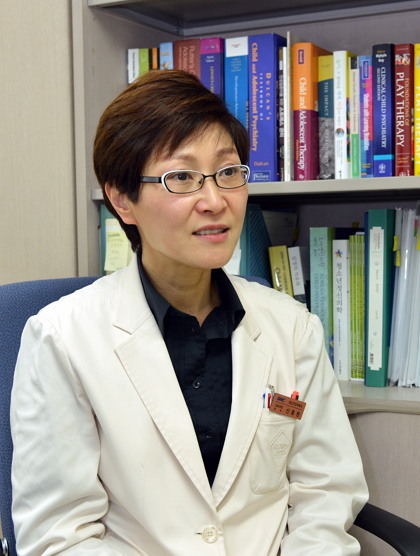Overuse of digital devices could hamper proper development of the brain and character, according to Sungkyunkwan University professor of psychiatry Shin Dong-won.
The brain needs time to “space out” to digest information, Shin said, but the constant inflow of information through digital devices could prevent the brain from carrying out this essential task.
“The brain works by alternating between concentrating and taking a break, and concentrating means focusing on outside stimuli. For 30 to 50 percent of the time, the brain is ‘spaced out,’” Shin said.
While it is commonly thought that the brain is fully disengaged when a person is “spaced out,” Shin said that the act of spacing out is a critical process, during which the brain is far from “empty.”
The brain is active even when a person is asleep. Shin said the brain is highly active when a person is spaced out, which is recognizable by a brainwave pattern particular to that state. If spacing out was useless, the process would have been eliminated during the millions of years it took for the human brain to evolve.
“(People) always carry their smartphones, search for things with the computer all the time; this way only external stimuli is being fed in at all times. (Your brain) needs time to space out and to digest and make information your own, but as that time becomes scarce, (the brain) gets overloaded.”
The brain needs time to “space out” to digest information, Shin said, but the constant inflow of information through digital devices could prevent the brain from carrying out this essential task.
“The brain works by alternating between concentrating and taking a break, and concentrating means focusing on outside stimuli. For 30 to 50 percent of the time, the brain is ‘spaced out,’” Shin said.
While it is commonly thought that the brain is fully disengaged when a person is “spaced out,” Shin said that the act of spacing out is a critical process, during which the brain is far from “empty.”
The brain is active even when a person is asleep. Shin said the brain is highly active when a person is spaced out, which is recognizable by a brainwave pattern particular to that state. If spacing out was useless, the process would have been eliminated during the millions of years it took for the human brain to evolve.
“(People) always carry their smartphones, search for things with the computer all the time; this way only external stimuli is being fed in at all times. (Your brain) needs time to space out and to digest and make information your own, but as that time becomes scarce, (the brain) gets overloaded.”

In addition to overworking the brain, Shin said that too much exposure to digital devices could interfere with learning to concentrate and to read human emotions, which in turn could adversely affect a person’s ability to resolve conflict.
According to Shin, there are two types of concentration, one of which is induced by interest while the other is achieved through training. The former can occur without effort, but the latter requires years of training and practice, Shin said.
“If you are exposed to digital (devices) or smartphones from too young an age, then the room for developing effort-based concentration becomes smaller,” Shin said.
In addition to the concentration problems, overexposure to digital stimuli hampers children’s acquisition of skills and makes it difficult to read human emotions as their primary interpersonal interactions are replaced in large part by digital devices.
“People observe faces to read emotions, and label them, and from there understand their context. If you understand the contexts and emotions, you can develop solutions,” Shin said.
“This is an ability you develop through human interaction. But when the generations that communicated mainly through things like KakaoTalk, SNS and computers reach their 20s and 30s, it is questionable how well their problem-solving abilities will have developed.”
Despite parents’ concerns that lacking a smart device would render their children outcasts, mobile messengers and other digital communications tools do not contribute to social development.
“Even without smartphones, sociable children make friends more easily off-line. This is a groundless worry,” she said.
Face-to-face interaction is more important at a young age, she said, and older people with lower plasticity but well-balanced brains can utilize different parts of the brain for different tasks.
Comparing stimuli for the brain to diet, Shin said that the human brain needs to be exposed to diverse stimuli to develop properly, but that the balance varies greatly according to age.
“Think of digital (technology) as food. Let’s assume that there is this new food that was discovered 10 years ago, and at first people went wild as if it was all that we needed,” she said.
“But, after a while people discovered problems such as addiction, and realized that while useful, consuming only this should be avoided. Digital is the same.”
According to Shin, addiction to digital technology works in the same way as the more conventional addictions such as alcoholism in that an addiction circuit forms. Once that happens, the only way to recover is to remove exposure altogether.
Shin, however, said that the use of digital devices should not be ruled out entirely, as long as balance is achieved with real human interaction.
“The brain’s plasticity changes. Areas of the brain that are used often develop strong (neural) networks, while unused parts less so,” shin said. “The way the brain functions is the result of tens of millions of years of evolution. (Digital technology) should be used with an understanding of the way the brain works.”
By Choi He-suk (cheesuk@heraldcorp.com)
-
Articles by Korea Herald










![[Hello India] Hyundai Motor vows to boost 'clean mobility' in India](http://res.heraldm.com/phpwas/restmb_idxmake.php?idx=644&simg=/content/image/2024/04/25/20240425050672_0.jpg&u=)








